31°45′2″N 34°58′30″E / 31.75056°N 34.97500°E


Tel Beit Shemesh is a small archaeological tell northeast of the modern city of Beit Shemesh.
It was identified in the late 1830s as Biblical Beth Shemesh – it then was known as Ain Shams – by Edward Robinson.[1][2] The tel was excavated in numerous phases during the 20th century.
- ^ Issa, Rana (19 April 2021). "Chapter 16 Missionary Philology and the Invention of Bibleland". Tracing the Jerusalem Code. De Gruyter. pp. 309–327. doi:10.1515/9783110639476-017. ISBN 9783110639476. S2CID 233588992.
For Robinson and Smith, the natives unwittingly carry the "divine dialect" of the land. Based on information from their lips, Robinson turns Ain Shams into the Bible's Beit Shemesh, Ain and Beit being so seemingly common as to be interchangeable.
- ^ Robinson, Edward (1841). Biblical researches in Palestine, mount Sinai and Arabia Petrea. Vol. 3. J.Murray. pp. 17–20.
The name 'Ain Shems implies a fountain; but there is now here no water of any kind, so called. The place to which the Arabs give this name, consists of the ruins of a modern Arab village of moderate size, with a Wely, all evidently built up with ancient materials. But just on the West of this village, upon and around the plateau of a low swell or mound between the Sărâr on the North and a smaller Wady on the South, are the manifest traces of an ancient site... Both the name and the position of this spot, seem to indicate the site of the ancient Beth-shemesh of the Old Testament. That city is described by Eusebius and Jerome, as seen from the road leading from Eleutheropolis to Nicopolis ('Amwâs), at ten Roman miles from the former city; and as they assign nearly the same distances from Eleutheropolis to Zorah, Zanoah, and Jarmuth, it is obvious that Beth-shemesh lay in the vicinity of these places. And so we had already found it, surrounded by Zânû'a in the East, Sur'ah in the N. N. E. and Yarmûk in the S. W. Indeed, from the existence of these names, and their coincidence with the accounts of Eusebius and Jerome, we had been able chiefly to trace out and fix the site of Eleutheropolis at Beit Jibrîn. The words Beit (Beth) and 'Ain are so very common in the Arabic names of Palestine, that it can excite no wonder should there be an exchange, even without any obvious ground. In the same manner, the ancient Beth-shemesh (Heliopolis) of Egypt, is known in Arabian writers as 'Ain Shems; although at present the name is applied specifically, only to a well at some distance from its site.
